
- Series: 1880s: Diamond Duos
- City: Brooklyn
- Team: Bridegrooms
- League: American Association
Bob Clark:
Robert H. Clark (1863-1919) cut his teeth in the fierce baseball rivalries between his native Covington KY and neighboring Cincinnati. He was enjoying a fine rookie season with Atlanta but caught the attention of the scouts when he was dragooned into catching after an injury to the starter. Bob came up with Brooklyn in 1886 and found great success there, handling all the staff. Bob was praised by the NY Clipper in ‘88 as one of the Bridegrooms’ most valuable players. During his five seasons in NY Clark hit a fine .241, but saw his average plunge after leaving Brooklyn in ‘91 for part time duty with Cincinnati and Louisville for one year with each club. Undoubtedly, Clark’s career highlights were the two Brooklyn pennants, first in ‘89 in the American Association and the following year when the franchise joined the National League.
- Clark died tragically from a fire back home in Covington at age 56
Mickey Hughes:
Michael J. Hughes (1866-1931) got 25 of his three-year career total 39 wins for the Brooklyn Bridegrooms in his rookie season, 1888. That performance earned Hughes the opening day start for Brooklyn in 1889, but he fell to a lackluster 9-8 record that year. Hughes was traded to the Athletics in 1890, finishing his brief ML tenure going 1-3 in six games.
- In Brooklyn’s final year in the American Association, Hughes went 1-0 in the 1889 Series against the NY Giants, won by NY 6 games to 3
Auction History
Cartophilia
Old Judge Pose: 76-6

- Series: 1880s: Diamond Duos
- City: Louisville
- Team: Colonels
- League: American Association
Paul Cook:
Paul Cook (1863-1905) got into three games at catcher for Harry Wright’s struggling Philadelphia Quakers at the end of the 1884 season. He returned to the minors before getting picked up by the Louisville Colonels where he stayed four years before jumping to Ward’s Wonders for the Players’ League season of 1890. Cook finished up the following year with three teams, back in Kentucky, then the Lincoln Rustlers and, finally, the St. Louis Browns. During his five years with the Colonels, Cook batted a mere .219 with no power.
- In his early days, Cook played for Muskegon in the Northwestern League, the Toledo Avengers of the Western League, and the Washington Nationals of the Eastern League
- Paul played in D.C. for manager Mike Scanlon who would lead the club in ‘86 as they joined the National League
Joe Werrick:
Joseph Abraham Werrick (1861-1943) broke into minor-league ball in 1884 with the Winona Clippers of the Northwestern League, moving to their St Paul franchise later that summer. Joe became a major-leaguer almost by accident as the Apostles of the Twin Cities became a late entry into the Union Association that September as the White Caps. Hitting less than a buck in nine games sent Werrick to the Nashville Americans of the Southern League in ‘85. The Louisville Colonels took him on in ‘86 and Joe rewarded them the following year with a terrific output: .285 BA, 99 RBI and 49 steals. Unfortunately, his average plummeted to .215 in ‘88 and Werrick sought the shelter of the minors for the remainder of his lengthy tenure. He played for various teams in the Virginia and Interstate Leagues, finishing up with the Mansfield Haymakers in 1899 showing he still had power with 11 HRs and a .297 average.
- In his short-lived debut, Joe participated in a unique “record.” St Paul was a last-minute fill-in for the moribund Union Assoc and played only nine road games--a “major league” team that never played a home game
Auction History
Cartophilia
Old Judge Pose: 92-1
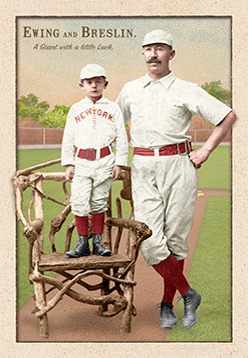
- Series: 1880s: Diamond Duos
- City: New York
- Team: Giants
- League: National League
- Hall: National Baseball Hall of Fame
Buck Ewing:
William Ewing (1859-1906) was the premier catcher of the 19th century, honored for decades after his early death as even, perhaps, the greatest player of all time. A scourge at bat, Buck hit over .300 ten times. He played behind the plate with courage and style, crouching close to the hitter so as to shave precious seconds off his inerrant throws. Ewing had debuted with the remarkable Troy Trojans in 1880 and joined four future Hall-of-Famers in moving to NYC in ‘83. The sturdy catcher may have been the primary inspiration for Jim Mutrie’s “my Giants!” exclamation that led to the new identity of the Gothams. An arm injury on a raw spring day curtailed his tenure behind the plate from 1891 on. Such a magnetic figure couldn’t escape the turmoil of the Players’ League controversies and Ewing was sometimes pilloried for lax effort. Despite such caviling, Ewing left as indelible a mark on the game’s first century as anyone. Upon his induction to Cooperstown (among the first six of the “pre-modern” era), he was hailed by Connie Mack as the greatest catcher he had seen and he had seen most.
- “Buck” was a derivative of “Buckingham,” bestowed on the budding star by an admiring scribe who wanted to add gravitas to the youngster’s reputation
- Played all nine positions and managed 3 different teams over 7 seasons
- Was the first catcher elected to the Hall of Fame; and the second 19th century player elected (after Cap Anson)
- Elected to Hall of Fame: 1939
Willie Breslin:
Master William Breslin was one in a line of NY Giants’ mascots in the 1880s, primarily due to HOF catcher Buck Ewing’s love of “hoodoos.” Superstition is still alive and well in baseball and goes back to its roots. In the old days it wasn’t rally monkeys, tomahawks or Phanatics–it was young boys recruited from the mean streets by ball players desperate for an edge. Lads such as “masters” Betsie and Preston prowled the NY dugout in 1886, preceded by an unknown “colored boy” that year. Any charm could do, though. Ewing seized on a yellow mutt, a ring-tailed monkey named “Mose,” or a toy barking dog. But no mascot seems to have gained the popularity and fame of Willie Breslin. He wasn’t the first to be given an Old Judge card (that was Willie Hahm in 1887), but he is the only one to have his own card as well as a famous pose with Ewing in a photo taken in 1884 and used on the OJ series of 1889. One of Buck’s proteges was Fred Boldt, a Chicago waif the team picked up on the road. Back in NY, young Fred ran up an account at a diner near the Polo Grounds and absconded with Cannonball Titcomb’s shoes.
- The Breslin Old Judge cards have become highly prized
- Sadly, biographical data for Willie and his cohorts is lacking. We trust he turned out better than young Boldt
Auction History
Cartophilia
Old Judge Pose: 149-11
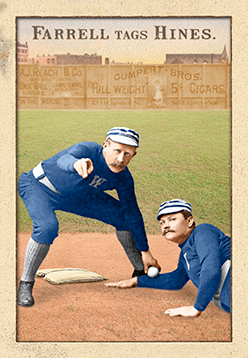
- Series: 1880s: Diamond Duos
- City: Washington, D.C.
- Team: Nationals
- League: National League
Jack Farrell:
John A. Farrell (1857-1914). Known as Moose, Farrell played 2nd base for 5 teams over 11 seasons. Jack also served as player/manager for the 1881 Providence Grays and achieved a 24-27 record before quitting as the captain. A light hitter, Jack’s defense was excellent and he either led or finished near the lead in many defensive categories for second basemen throughout his career.
- Led NL in assists with 365 in 1883
- Led NL in assists for 2B twice: 1881 & 1883
- Led NL in double plays for 2B in 1883
- Led NL in FLDG% for 2B in 1883 with .924
- Ranks 26th all-time in range factor at 2B
Paul Hines:
Paul Aloysius Hines (1855-1935). A hearing-impaired center fielder for 16 professional seasons, Hines accumulated the most hits in the first 5 years of National League history and, upon his retirement in 1891, was 3rd all-time in hits behind Cap Anson & Jim O’Rourke.
- Won baseball’s 1st Triple Crown: 1878
- May have recorded the 1st unassisted triple-play in history
- Twice won the batting title
Artist's Note:
- The uniform colors on this card were changed in April, 2017 from black to blue to reflect recent reliable research by Craig Brown & friends at Threads of Our Game. Two cards were previously released featuring black uniforms.
Auction History
Cartophilia
Old Judge Pose: 154-3

- Series: 1880s: Diamond Duos
- City: Philadelphia
- Team: Quakers
- League: National League
Charlie Ferguson:
Charles J. Ferguson (1863-1888) was considered by future Hall of Famer Wilbert Robinson to be the 5th best player of all-time when Ferguson succumbed to typhoid fever at age 25. Primarily a pitcher for the Quakers over four seasons, the right-hander also handled the outfield and second-base. He won at least 21 games each year and was lights-out in 1886, winning 30 with a 1.98 ERA (2nd in the league). Playing more outfield the next year, Ferguson not only won 22 but drove in 85 with a .327 average. The youngster was stricken before the ’88 season and never recovered.
- Hurled a no-hitter against the Providence Grays on Aug 29, 1885
- In tribute to this young warrior, the Quakers and three other NL teams wore black crepe for the entire 1888 season
- Decades later, W.B. Hanna dubbed him “the game’s best all around player”
- Robinson ranked Ferguson 5th all time after Cobb, Keeler, Ruth and Wagner
Tommy McCarthy:
Thomas Francis Michael McCarthy (1863-1922) failed as a pitcher, but established himself as a fast and intelligent outfielder and base runner over 13 professional seasons. While with the Boston Beaneaters from 1892-1895, he and Hugh Duffy were called the “Heavenly Twins” as they comprised one of the best outfield tandems of the era.
- Had a .292 lifetime average
- Although records are incomplete, he probably stole 500+ bases
- Introduced the Hit & Run play
- Elected to Hall of Fame: 1946
Auction History
Cartophilia
Old Judge Pose: 157-4
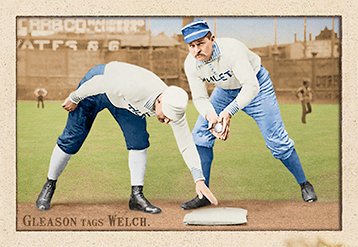
- Series: 1880s: Diamond Duos
- City: Philadelphia
- Team: Athletics (AA)
- League: American Association
Bill Gleason:
William G. Gleason (1858-1932) was an American Association shortstop for three teams from 1882-89. During those eight seasons Gleason hit .267. He debuted with his hometown St. Louis Brown Stockings and participated in their three pennants in '85, '86 and '87. He was an everyday player and increased the number of games played every year with the club, culminating in '87 when he appeared in 135 games with a fine .288 average. St. Louis management must have anticipated a decline was in store. He was traded to Philadelphia's Athletics in '88, where his hitting fell off to .224. Philly dealt him to the Louisville Colonels for his final campaign. Gleason saw action in only 16 games in 1889. He stayed in pro ball for two more minor league seasons with Washington of the Atlantic Association in 1890 and finished up with the Rockford Hustlers of the Illinois-Iowa League the following year where he recorded by far the highest average on a squad that included eight other past or future big leaguers.
- In a storied and rowdy “championship” contest following the 1885 season, Gleason's Browns vied with the formidable White Stockings. Bill was at the center of the storm as his throw to first was ruled late, infuriating the home folks and precipitating a long row in which Cap Anson refused to allow the Chicago umpire to be replaced. Comiskey called his team off the field which led to a forfeit of the first game. The “Series” ended in a tie.
Curt Welch:
Curtis Benton Welch (1862-1896). Primarily a center fielder for 10 professional seasons, Welch was a fast runner with great instincts. His “$15,000 slide” into home clinched the 1886 World Series for the St. Louis Browns. It has been called the most famous play of the 19th century.
- Top 10 in steals 6 years in a row
- Currently ranks 51st all-time in steals (453)
- Alleged to have hidden beer behind billboards so he could drink during games
Auction History
Cartophilia
Old Judge Pose: 485-7
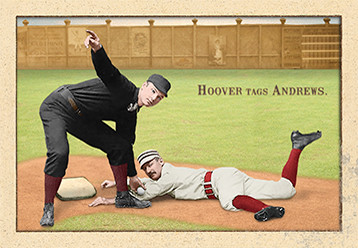
- Series: 1880s: Diamond Duos
- City: Philadelphia
- Team: Quakers
- League: National League
Buster Hoover:
William James Hoover (1863-1924) was a prime example of players from the beginning of baseball who could shine at the amateur or minor league level and fail when up against the true elites of the game. In Buster’s case, the exception (the Union Association of 1884) proves the rule. That is where Hoover began in the “majors” but was really playing against minor-league caliber opponents. He wowed, hitting .364 (2nd in the league), third in OBP and slugging. Then that quixotic misadventure ended and the players had to find real homes. Buster’s was still in Philadelphia with Harry Wright’s Quakers where he hit .190. After years mostly in the minors (where he often excelled, averaging .306 over 11 seasons) he got a shot with the Orioles and hit .217. Finally, the Cincinnati Reds gave him a try in 1892: 14 games, .176. Hoover finished up hitting .305 for the Troy Washerwomen in 1894.
- Bill James has thoroughly analyzed the quality of the Union Association and found that it, like the anonymous Wisconsin dairy, could have embraced the motto: “Our Best Is None Too Good”
Ed Andrews:
George Edward Andrews (1859-1934) was an outfielder for the Philadelphia Quakers from 1884-89 before becoming caught up in the turbulence of the early ‘90s when leagues and teams were forming and folding with abandon. He played the last year of the Indianapolis Hoosiers’ franchise in 1889, then for the Players’ League (John Montgomery) Ward’s Wonders of Brooklyn in 1890 and (Mike “King”) Kelly’s Killers in Cincinnati in 1891, his last season in the majors. Andrews’ lifetime batting average was .257 with more hits (830) than games played (774).
- The speedy Andrews stole 35+ bases three times, including a NL-leading 56 in 1886
- The Ohio native was a rare college graduate in the early days of baseball, an alumnus of Case Western Reserve University in Cleveland
Auction History
Cartophilia
Old Judge Pose: 9-6
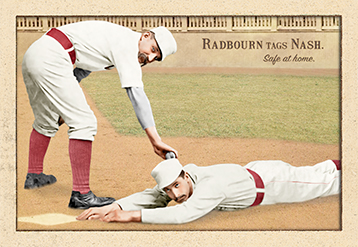
- Series: 1880s: Diamond Duos
- City: Boston
- Team: Beaneaters
- League: National League
- Hall: National Baseball Hall of Fame
Old Hoss Radbourn:
Charles Gardner Radbourn (1854-1897). An elite pitcher for 5 teams over 12 seasons, Radbourn owns the single-season Wins record with either 59 or 60 (sources vary) in 1884 – the year in which he became baseball’s 2nd triple Crown winner with 441 Ks & a 1.38 ERA. In 1884, Radbourn started 40 of his team’s last 43 games and won 36 of them. In the 1884 World Series, Radbourn started and won all three games, giving up only 3 runs. Including the postseason, Old Hoss won 62-63 games in 1884 and threw over 700 innings.
- NL Triple Crown: 1884
- NL Wins champ: 1883, 1884
- 309 career Wins
- Pitched no-hitter: 1883
- Elected to Hall of Fame: 1939
Billy Nash:
William Mitchell Nash (1865-1929) made one invaluable contribution to baseball: he scouted & recruited Napoleon Lajoie, bringing him to the Philadelphia Phillies in 1896. By that time, Nash had mostly played out his ML career as a steady-hitting 3rd baseman for the Boston Beaneaters. He compiled a respectable .275 lifetime average and, in 1895, was declared by Sporting Life magazine “the best fielding third baseman in the League.” Traded for future Hall of Famer Billy Hamilton to the Phillies, Nash was player-manager when he found Lajoie who was pounding the ball for the Fall River Indians in the New England League.
- Nash broke into the majors with his hometown Richmond Virginians of the old AA in 1884 before finding a home wih the NL Beaneaters
- Best year was 1887: .295 AVG with 84 RBI
- Bill James ranks Nash 49th amongst third basemen all-time
- Sporting Life touted his $7500 compensation in ’91 as money well-spent
Auction History
Cartophilia
Old Judge Pose: 377-2
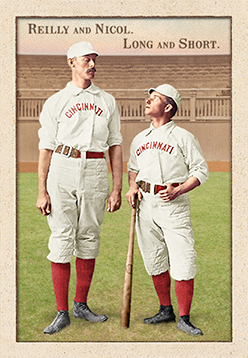
- Series: 1880s: Diamond Duos
- City: Cincinnati
- Team: Red Stockings (AA)
- League: American Association
John Reilly:
John Good Reilly (1858-1937) was a one-man Big Red Machine long before the days of Bench, Morgan and Rose. When he was replaced at first base by Charles Comiskey in 1892, Long John held the Cincinnati record in singles, doubles, triples, home runs, runs scored, RBI, and games played. His decade with the Reds had seen Reilly consistently rank in the league top ten in most offensive categories. In addition, his lean 6’3” frame made him a welcome target for his teammates. To this day, after more than a century of powerhouses in the Queen City, Reilly remains one of only four in team history to twice lead the league in HRs. In 2012 he was inducted into the Cincinnati Reds Hall of Fame, which according to the team’s website is the oldest continually operating team Hall of Fame.
- Reilly had been orphaned at age three when his father died in the Battle of Fort Donelson while serving as captain of a Union ironclad gunboat
- Long John grew up in Cincinnati as a professional artist until lured by his love of baseball. He was loyal to his hometown, retiring rather than moving to another club
- Career home runs were impressive for the era at 69
Hugh Nicol:
Hugh N. Nicol (1858-1921) was one of the great “little men” in all of baseball. This Scottish immigrant arrived in Rockford, IL in 1865 and grew up playing a mid-west style of ball that would suit him for great accomplishments in the major leagues. After only two years with his hometown White Stockings, the Chicago version called him up to Cap Anson's powerhouse in 1881. He was only a part-timer for the champion club in his first two seasons before his speed caught the attention of Chris Von der Ahe and Hugh moved to the Browns. “Little Nic” became a favorite with his outfield speed and accurate arm. Measuring speed on the bases is particularly challenging in evaluating 19th century players as “stolen bases” didn't factor into record-keeping for a long time and rules changed into the '90s. Nevertheless, Nicol's 138 steals credited in 1887 surely rank him among the greats. SABR's Charles Faber notes that this accomplishment came at age 29, leaving it to the imagination how many this speedster swiped in his early years. Hugh set this all-time record for his new club, the Reds, after being part of MLB's first trade. Von der Ahe sent Nicol to Cincinnati for Jack Doyle and $400 after the '86 campaign. His fame preceded Hugh to the Queen City, as reported by The Sporting News: “Hugh Nicol's addition to the Cincinnati team means chain-lightening on the bases. He is worth all the young blood in Christendom.” The diminutive (5'4” 145lbs) utility man never hit very well, although he did shine in his first season in St Louis with a .285 average. His ten-year ML tenure saw him hit .235 for three clubs before returning to the minors and a managerial career that lasted through the 1905 season with various Illinois teams.
- The light-hitting Nicol had a highlight game for the Browns in late 1883 as the club was seeking to overtake the Phils. Hugh went five-for-five with a walk and scored five times. The Browns fell one game short of Philadelphia for the pennant
Auction History
Cartophilia
Old Judge Pose: 346-7

- Series: 1880s: Diamond Duos
- City: Philadelphia
- Team: Quakers
- League: National League
Pop Schriver:
William Frederick Schriver (1865-1932) was a durable catcher for several mostly National League teams from 1886 through 1901. His debut for the AA’s Brooklyn Grays was his only stint outside the NL. Pop had a solid .264 lifetime batting average over a 14 year major league career. During his time with Cap Anson’s Colts, to promote a game with the Senators, battery-mate Clark Griffith made a 555’ “toss” to Schriver (off the Washington Monument). Accounts differ on Pop’s performance and Griffith later said Schriver dropped the ball. In any case, history has credited Gabby Street with the first successful accomplishment of the stunt, largely on the testimony of Griffith who by then was owner of Street’s Senators. In 800 games, Schriver made 720 hits in 2,727 at-bats.
- During 1894, the year of the D.C. feat, Pop was among the league leaders in most defensive categories
- In 1901 Schriver led the league in throwing out runners attempting to steal
Charlie Bastian:
Charles J. Bastian (1860-1932) was the model “good field, no hit” infielder, squeezing 4 different leagues and 6 teams into his 8 year career. He started in MLB with the Wilmington Quicksteps of the evanescent Union Assoc’s only year, 1884, and finished with a game in the Players’ League in 1891.
- Lifetime BA of .189 defeated his finesse in the field
- Led all NL second-basemen in fielding % in 1886
- His main club was the Quakers, who were the Phillies when Bastian returned for one game in ‘91
Auction History
Cartophilia
Old Judge Pose: 23-6
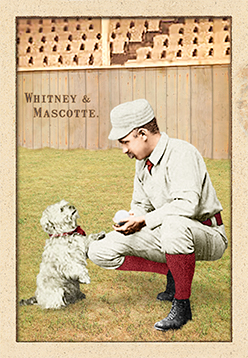
- Series: 1880s: Diamond Duos
- City: New York
- Team: Giants
- League: National League
Art Whitney:
Arthur Wilson Whitney (1858-1943). Art played 3rd base for 8 different teams over 11 major league seasons. A below average hitter, his best year may have been 1886 with the Pittsburgh Alleghenys when he compiled 122 hits, 13 doubles, 4 triples, 15 steals & 70 runs with a light .239 batting average.
- 2x World Series Champion with the New York Giants: 1888 & 1889
- Although I haven't quite figured it all out, it appears Whitney was part of a fairly distinguished baseball family. His brother Frank played for the Boston Red Stockings in 1876; Charles Whitney, who played minor league ball from 1879 to 1889, was also likely Art's brother; and research suggests that 10 year major league veteran Grasshopper Jim Whitney may have been a cousin.
Mascotte:
This dog's name and relationship to Art Whitney and/or the New York Giants has been lost to history. I have no evidence that this dog ever served as the team's mascot, but she does appear to be wearing a handkerchief in the team's colors. The Giants (Buck Ewing in particular) were notoriously superstitious about their mascots. At one time or another between 1884 and 1890, the Giants "employed" at least five children: Masters Boldt, Bretsie, Preston, Breslin and an unidentified "colored boy," a yellow mongrel dog who was eventually captured by animal control and euthanized, and a toy rubber dog that barked when squeezed.
Despite the mystery surrounding this dog, her presence and photogenic posing created what REA has described as "one of the most unusual and memorable images to ever appear on a baseball card." It has been suggested that this image was staged and intended by the Goodwin photographers to represent a sort of comedic complex irony. Between the minor and major leagues, Art Whitney played for 12 different teams over 17 professional seasons and twice sued his team in contractual disputes. Even in an era when few players stayed with any one team for more than a year or two, Whitney's lack of loyalty was possibly renowned and cast into stark contrast in this photo by the adoring attention he is being given by man's best friend, the ever-loyal dog.
Whether the meeting between the two was devised or a genuine moment in time caught by a Goodwin photographer, I think the image's appeal is due to something simple we can all relate to: it's fun.
In fact, this is perhaps the image that most directly inspired the idea behind the Ars Longa 1880s series. In the nascent stages of my work, when this was all but an amorphous and rudimentary idea, I saw this image and thought how fun it would be to colorize it. Three and a half years and nearly 750 cards later, here it is.
Auction History
Cartophilia
Old Judge Pose: 499-1
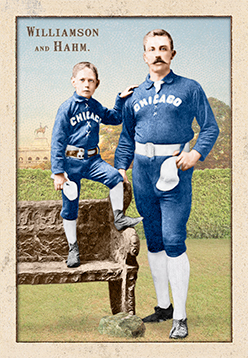
- Series: 1880s: Diamond Duos
- City: Chicago
- Team: White Stockings
- League: National League
Ned Williamson:
Edward Nagle Williamson (1857-1894). A 3rd baseman & shortstop for 3 teams over 13 seasons, Ned was an above average hitter & excellent defender (despite his portly physique). Ned held the single season HR record (27 in ’84) until topped by Ruth’s 29 in ’19. Ned’s career was shortened by a knee injury he sustained while participating in Al Spalding’s baseball world tour.
In 1894, the Reach Guide convened a panel of 11 former ballplayers, including HOFer Jim O'Rourke, to debate who was the greatest baseball player of all time. The panel concluded that the honor belonged to Ned Williamson. Cap Anson himself called Ned "the greatest all-around ballplayer the country ever saw."
- Won 5 NL pennants
- Played in two World Series
- Once owned single season doubles record: 49
Willie Hahm:
Willie Hahm, also known as “Master Willies,” was a rarity among early baseball mascots. He was white. The youngster, said to have been barely able to talk when first brought to the dugout, was the diminutive talisman for the Chicago White Stockings in the mid-1880s. “The Chicagos have great confidence in him as a promoter of success and make a great fuss over him” said Louisville Colonels manager Jim Hart in one of the earliest interviews explicating the curious role of mascots in America’s game. After triumphing in the 1884 campaign, Hart said the Sox had paraded Hahm at the head of their procession in an open landau. The Chicago Tribune reported on a big match with the rival Wolverines on June 18, 1886. Al Spalding brought a trainload of boosters to Detroit in hopes of preventing the eclipse of Chicago’s record home winning streak. Downtown Motor City was treated to the spectacle of the White Stockings and 200 rabid fans marching from the depot to the Russell Hotel carrying broomsticks with Willie Hahm leading the throng. Later, per the Tribune, “The Chicagos were escorted to the ground by a band, and entered the field behind little Willie Hahm, who carried an immense broom on which were written the words Our Mascot.”
- Many of the early mascots were black kids dragooned by superstitious players such as NY’s Buck Ewing
Artist's Note:
- The uniform colors on this card were changed in April, 2017 from black to blue to reflect recent reliable research by Craig Brown & friends at Threads of Our Game. Two cards were previously released featuring black uniforms.
Auction History
Cartophilia
Old Judge Pose: 502-7











